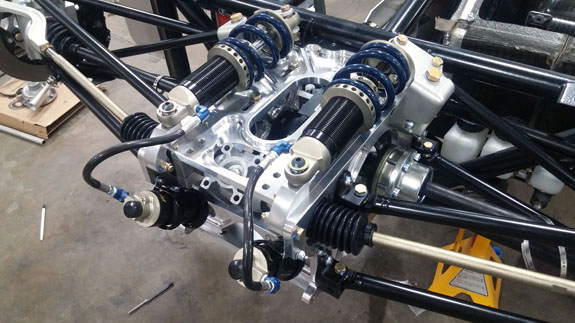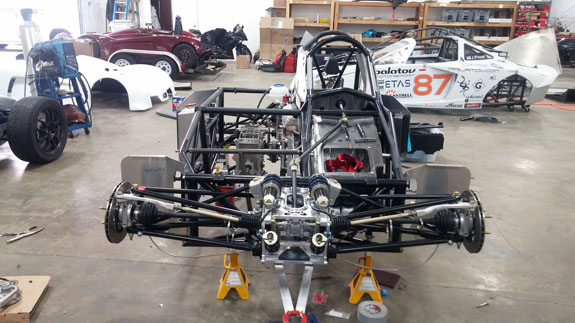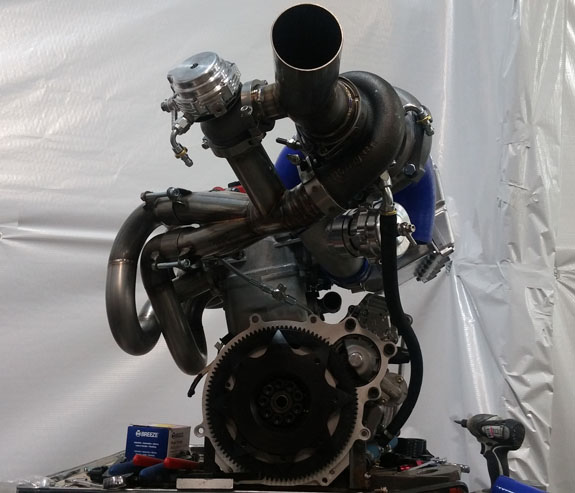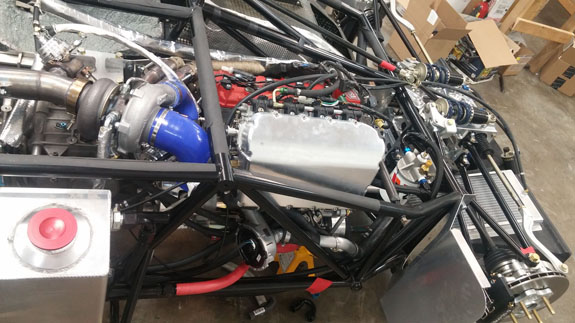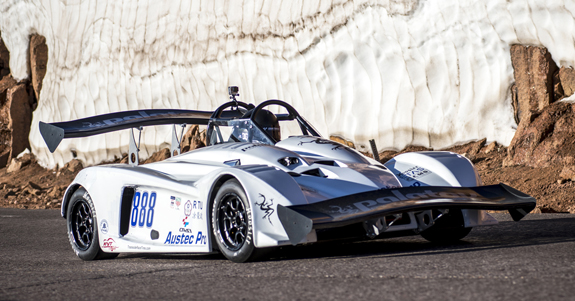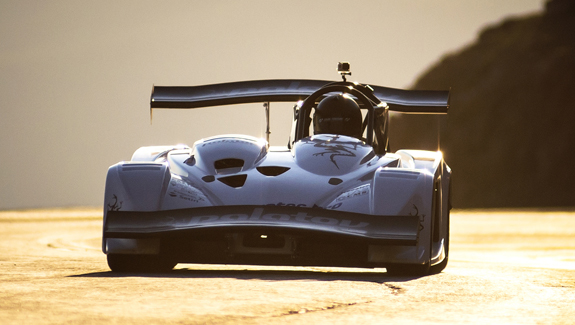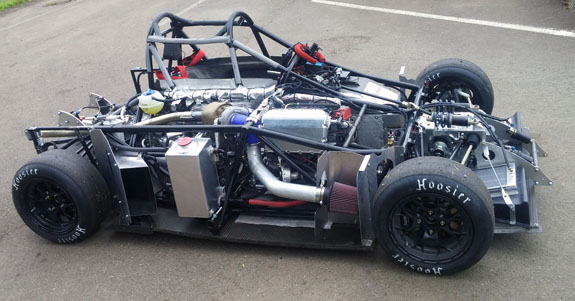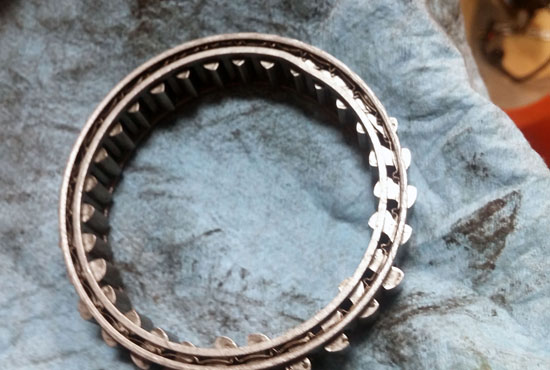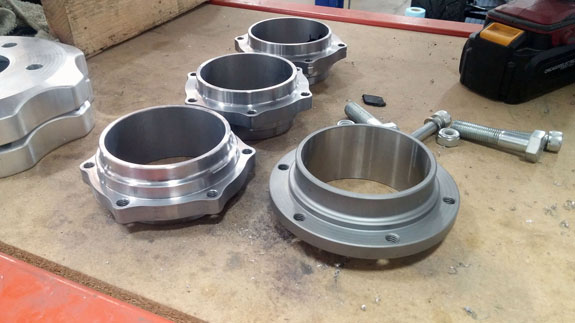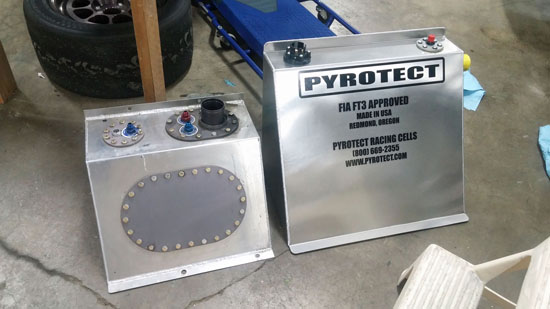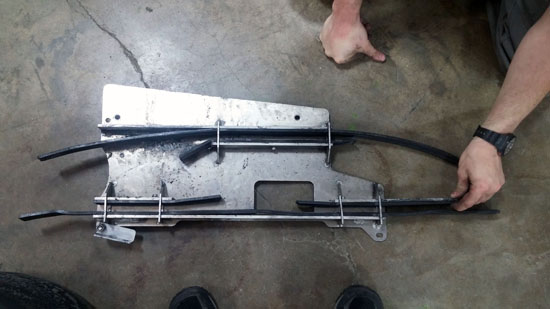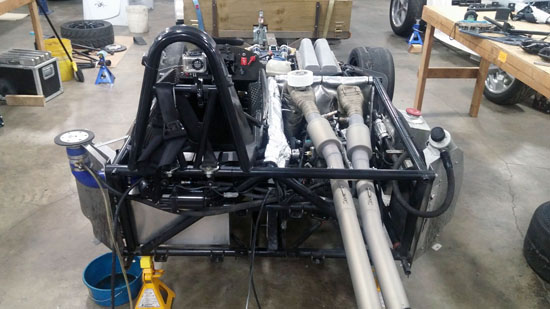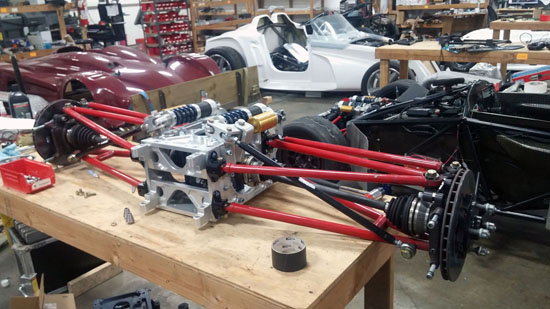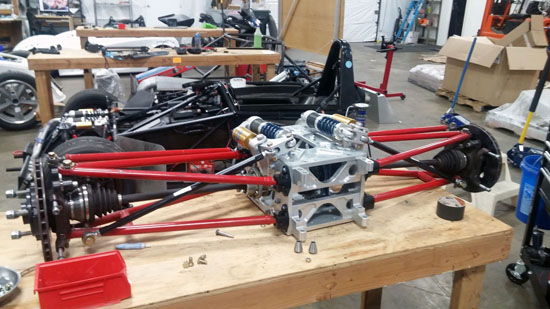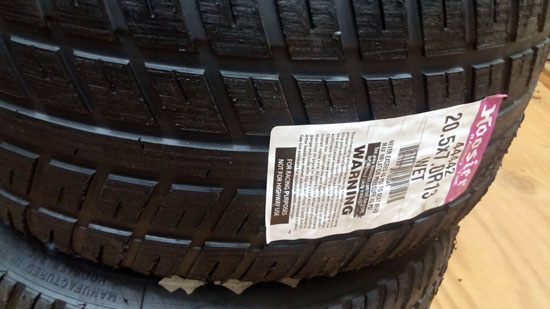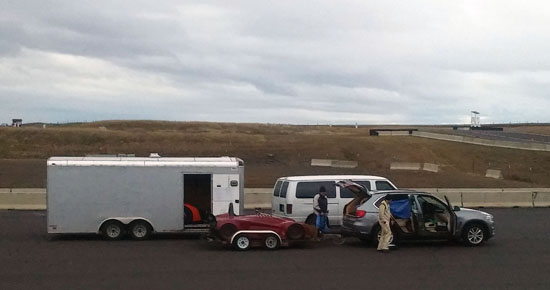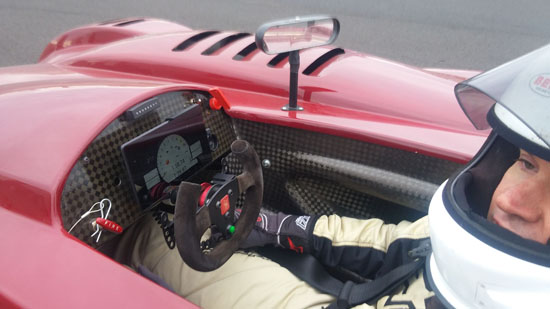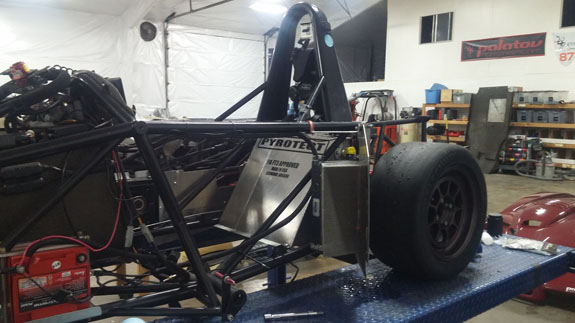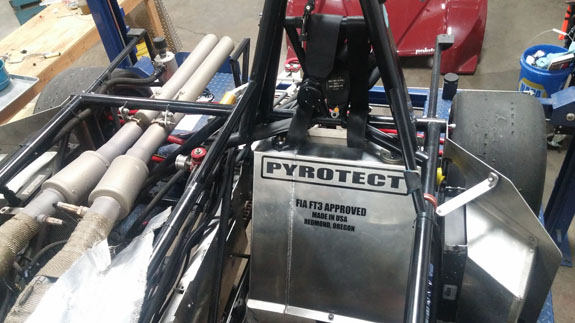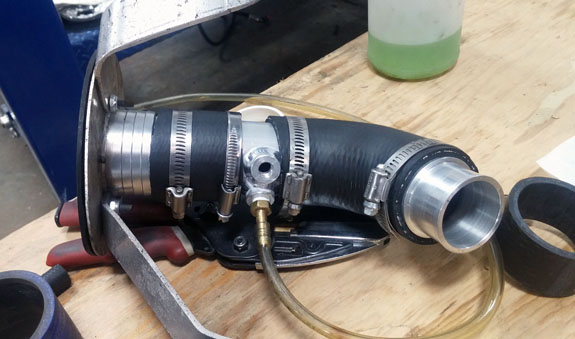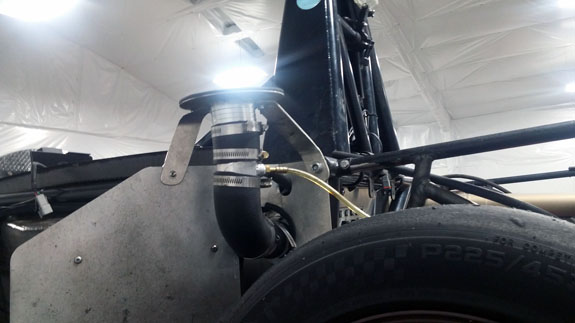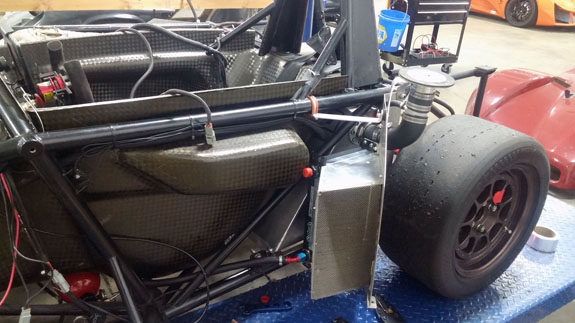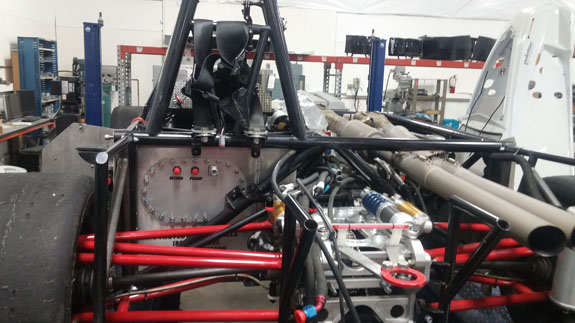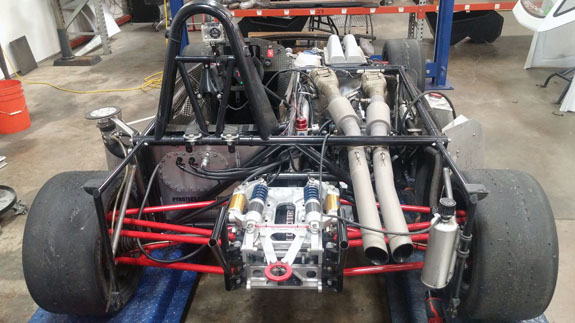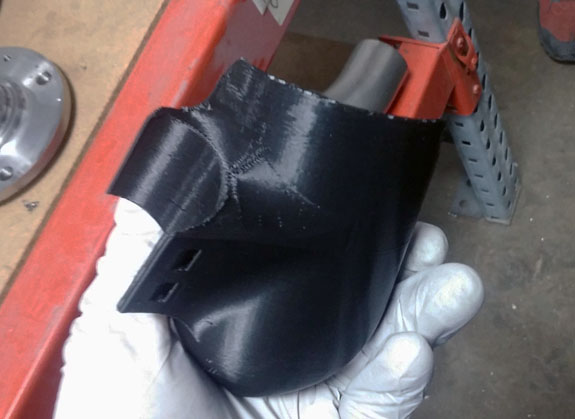|
07/07/2016 Running the D1 has become pretty routine for Neil, with only a bit of basic maintenance required. Between that and all our attention being on Pikes Peak effort the past few months, there hasn't been much reason to post. Racing does improve the breed, and this year our participation in the hillclimb resulted in significant evolution of the D1 platform. One key item is the introduction of new generation suspension boxes.
The new design is more rigid, slightly lighter, and more compact allowing for both additional crush space and better routing of plumbing. Another big item is the turbocharged 4 cylinder Hartley engine, producing over 350 hp. It is a milder and less expensive alternative to the V8, yet still very potent.
Another tweak is the new aero setup with front and rear wings that are quickly removable for transport and service. The design was first developed in CFD and then verified by testing.
Even though the Pikes Peak car wasn't completed until just 9 days before the race, and had some tuning issues at altitude that didn't get handled until the day before, it still posted a 10:06 and a third place in the Unlimited class with owner Rodney Tu driving. This performance was all the more impressive considering that it was Rodney's first time on the Mountain, and the race run was the first time the car was able to run anywhere close to full power. The evolution of the D1 platform will continue as we are now looking into Motus engines, both normally aspirated and with forced induction, as a way of making the car more accessible price-wise while maintaining a high level of performance. I'm really excited about the possibilities.
11/30/2016 Neil has now put over 60 hours at speed on the D1. And not just any speed, this is now close to LMP pace. The car has held up remarkably well - all the major systems are functioning properly. But as with any high performance machine, maintenance is required and we did have some component failures. One is the proprietary torque splitter that drives the front wheels on demand (rears are always driven). At peak power in first gear, the output shaft from the gearbox sees over 2,100 lb-ft of torque. The chassis excels at providing traction, so all of this is going to the ground instead of going up in smoke. Add shock loads due to bumps and components will get stressed. I was actually impressed the unit lasted this long.
The hardened alloy steel case had split and the one-way clutch assembly had distorted. Not being one to resist learning from a component failure, I redesigned the unit to make it stronger. Then went to the trouble of machining, heat-treating and precision grinding a new batch (on the left, compared to old unit on the right).
The Pikes Peak D1PPS was updated with the new design. Speakng of which, Rodney's car was featured in the Austec Pro booth at SEMA show in Vegas recently (Austec Pro is Rodney's company which manufactures premium suspension components, and we are the US distributor for the line - more on that soon).
For some time now Neil has been asking for a larger capacity fuel cell, since at his current pace the existing 5-gallon tank only provides about 17 minutes of run time (translates to roughly 6 mpg). In order to fit one, the new generation rear suspension box must be installed first. This will have the added benefit of reverse-caster geometry, hoping to improve stability at speed. And while we're at it, a new slightly slower-ratio steering rack is fitted to provide more precision in guiding this missile. Rodney's D1PPS is already equipped with the new parts and it is noticeably easier to drive. Rear chain guides and a new chain complete the updates for Neil's car.
A couple design mistakes on my part required the fuel cell to be sent back for modification, but we did get everything else installed and this past sunday we went out to ORP for testing. Forecast was rain and maybe snow, so Neil got a set of rain tires.
This is one of the most certain ways to prevent rain and sure enough, it worked! The day turned out cold and windy (35-40F and 10-20mph) but dry.
The most encouraging thing we learned is that the new rear suspension setup does make the car noticeably more stable, and the new steering rack provides meaningful improvements in precision. It is now very similar to the D1PPS and this validates the changes. The goal was also reduced effort but that was not as readily apparent, according to Neil, as I anticipated. I might have to drive it as well to get another perspective - in the name of science, of course! All good data points and testing will continue. So will the development. We have a pretty ambitious list already. 12/27/16 Finally done with the fuel cell upgrade. It involved getting a brand new bladder made and cutting/welding of the aluminum container, as well as a number of other tweaks and mods. Like making two adapters for the filler neck, turning the transmission oil cooler 180 degrees, making new oil and air lines, relocating the electric transmission oil pump and paddle shift compressor, modifying frame brackets and so on. Everything is connected to everything else.
But now it's all done.
As you may recall the upgrade was precipitated by Neil's increased speed, dropping from the mid 1:20s to mid teens at PIR with chicane, and the attendant increase in fuel consumption. He used to get over 40 minutes from the old 5-gallong tank, and was now only getting about 17 minutes. The upgrade to around 8 gallon capacity will enable him to once again complete a full 20-25 minute track session at the faster pace. But that won't be happening until weather gets more agreeable - currently ORP has snow and 7-degree lows. Yes, the idea of getting snow tires and giving it a go has been floated again, but I can understand Neil's hesitation in taking his 1,100 lb, 430hp, $150K car on a snow-covered racetrack with 140' elevation change. Even just getting there is a challenge this time of year. 1/21/17 Neil's D1 is now updated and ready to hit the track again, as soon as the weather clears. About a foot of snow on the ground at ORP right now but it's been getting warmer. In the meantime we've been making tweaks to Rodney's D1PPS, with the installation of a boost controller and relocating the AFR gage to a custom 3D printed 'pod' that Jay designed and made.
3D printing is now practical for one-off small parts like this. As I've said before, I really look forward to when structural metal 3D printing becomes practical and cost-effective for our application. When that happens, it will enable a significant step forward in the optimization of our designs. The reason for giving the AFR gage such prominent placement is that we plan to do more engine tuning this spring. It's difficult to put the diminutive AWD D1 on a chassis dyno, so just doing pulls on the front straight at ORP is an effective way to get some tuning done. We did this in a parking lot at Pikes Peak International Raceway last year, and it worked well. Being able to see AFR during the pull helps quickly pinpoint any areas that need attention, as well as shut down a run if the mixture is too far out before any damage is done. And of course we have datalogging we can look at for detailed analysis. 2017 will be another year of much learning and progress. We already have a head start. Site Sponsors and Links:
|

